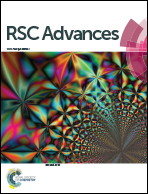Continuous biocatalytic recovery of neodymium and europium
Abstract
Batch-grown cells and a continuously-grown biofilm of a Serratia sp. were utilized to recover the rare earth elements (REEs) lanthanum and neodymium from solution. Selectivity was obtained for La(III) over Th(IV) using columns of polyacrylamide gel-immobilized cells challenged at a rapid flow rate, exploiting the different solution chemistries and behaviors of REEs(III) and Th(IV). Biofilm-grown cells had a ten-fold higher activity of mediating phosphatase, which promotes metal deposition as the corresponding metal phosphate, reflected as a correspondingly enhanced level of removal of Nd(III) (as NdPO4) in flow-through columns utilizing the biofilm on reticulated foam. The biofilms retained activity in the removal of Nd(III) for >1 year, losing activity exponentially with a half life of 3 months. The flow rate giving 50% removal (FA1/2) of Nd(III) by 3 month old biofilms at pH 5.5 was 272 and 275 mL h−1 using two independent biofilm preparations, equivalent to a FA1/2 of 34 column volumes per h for fresh biofilms. The removal of Nd(III) was sustained at pH values down to 3.5 with approx. 20% of the column activity lost upon return to pH 5.5. A similar result occurred in the presence of the common REE leaching agent ammonium sulfate (100 mM), but this did not affect the ability of Serratia sp. to recover REEs. With a view to the potential for future biomanufacturing of Nd(III)-catalysts, the deposited material was identified as NdPO4 by X-ray powder diffraction with a nanoparticle size of 14.5 nm, irrespective of the biofilm age.


 Please wait while we load your content...
Please wait while we load your content...